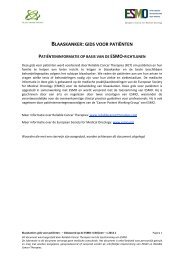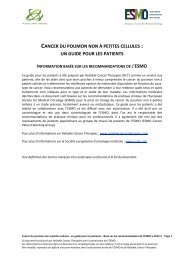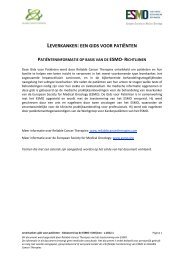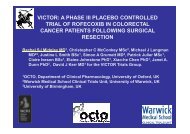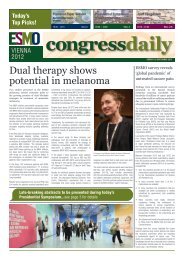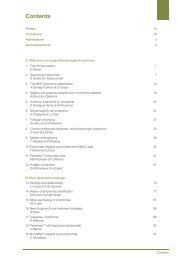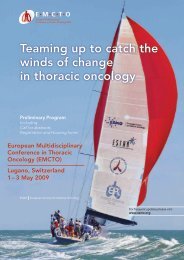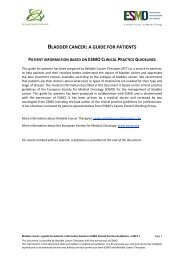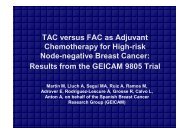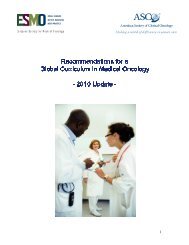Tu ESMO Imaging of glioma.ppt
Tu ESMO Imaging of glioma.ppt
Tu ESMO Imaging of glioma.ppt
Create successful ePaper yourself
Turn your PDF publications into a flip-book with our unique Google optimized e-Paper software.
<strong>Imaging</strong> <strong>of</strong> <strong>glioma</strong><br />
MPI/Uni Cologne<br />
Herholz Molecular Centre Manchester, UK 33rd<strong>ESMO</strong> Congress, Stockholm Karl Herholz<br />
14-16, 2008 Wolfson Molecular <strong>Imaging</strong> Centre Manchester, UK 33rd<strong>ESMO</strong> Congress, Stockholm Sept 14-16, 2008<br />
<strong>Imaging</strong> Wolfson Sept
mm<br />
Spatial resolution<br />
cm<br />
Human <strong>Imaging</strong> Methods<br />
MRI<br />
CT<br />
PET<br />
SPECT<br />
MRS/CSI<br />
proton spin, density, diffusion<br />
X-ray attenuation<br />
blood flow<br />
blood/tissue oxgenation<br />
glucose metabolism<br />
amino/nucleic acid metabolism<br />
transmitter metabolism<br />
receptor density<br />
cell labeling<br />
tissue pH<br />
metabolite/drug concentration
Glioma Grades and Prognosis<br />
WHO grade Median survival Histological types<br />
1 Cure possible Pilocytic astrocytoma (children)<br />
2 10-16 years Oligodendro<strong>glioma</strong><br />
2 6-8 years Astrocytoma<br />
3 3 years<br />
4 3-24 months Glioblastoma<br />
Anaplastic Astrocytoma<br />
Anaplastic Oligodendro<strong>glioma</strong>
Contrast enhanced T1-weighted MRI
Quantitative dynamic contrast-enhanced<br />
MRI in glioblastoma
Tractography<br />
Non-isotropic diffusion-weighted MRI<br />
Diffusion-Tensor <strong>Imaging</strong> (DTI)<br />
Normal<br />
Displacement and distorsion <strong>of</strong><br />
fibre tracts by glioblastoma<br />
Image-derived parameters: Mean diffusivity and fractional anisotropy
Magnetic resonance spectroscopy (MRS)<br />
Resonance shifts induced by (mostly endogeneous)<br />
millimolar substrate concentrations<br />
• H-1 (protons):<br />
– Choline (increased in most <strong>glioma</strong>s),<br />
– NAA (intermediary metabolite <strong>of</strong> normal brain)<br />
– Lactate (in some <strong>glioma</strong>s, below detection in bormal<br />
brain)<br />
– Creatine, Lipids, (Alanine, Acetate, Succinate)<br />
• P-31: ATP, PCr, inorganic Phosphate, Phosphoesters, pH<br />
• C-13 (exogeneous): Glycolysis<br />
• F-19 (exogeneous): Fluorinated drugs
Indicators <strong>of</strong> malignant degeneration<br />
Vascular changes<br />
• Increase <strong>of</strong> vascularity<br />
– Endothelial activation:<br />
Amino-Acid PET/SPECT<br />
– Blood volume and blood<br />
flow:<br />
• Dynamic CT,<br />
perfusion/diffusionweighted<br />
MRI<br />
• SPECT, PET<br />
• BBB breakdown<br />
– MRI/CT contrast<br />
enhancement<br />
Cellular changes<br />
• Increase <strong>of</strong> glycolysis<br />
– FDG PET<br />
– MRS: lactate<br />
• Change <strong>of</strong> lipid metabolism<br />
– PET: C11/F18 choline,<br />
acetate<br />
– MRS: increase <strong>of</strong> choline,<br />
altered phospholipid signal<br />
• Increase <strong>of</strong> cellular proliferation<br />
rate<br />
– Nucleoside PET (requires<br />
BBB damage for uptake)
<strong>Imaging</strong> blood volume and flow<br />
Technique Contrast Agent/ Tracer Biomarkers<br />
Dynamic contrast enhanced CT<br />
(DCE-CT)<br />
Dynamic relaxivity enhanced MRI<br />
(DRCE-MRI)<br />
Dynamic susceptibility enhanced<br />
MRI (DSCE-MRI)<br />
Nonionic iodine containing<br />
contrast<br />
Standard small molecular<br />
weight Gd based contrast<br />
agent<br />
Xenon-CT Inhaled Xenon Blood flow<br />
Arterial Spin Labeled MRI (ASL) Endogenous water Blood flow<br />
Quantitative phase contrast<br />
imaging (MRI)<br />
Single photon emission<br />
tomography (SPECT)<br />
Positron emission tomography<br />
(PET)<br />
Endogenous water<br />
99mTc-HMPAO<br />
133Xenon<br />
123I-IMP<br />
15O-water<br />
11C-butanol<br />
15O/11C-CO<br />
11C/62Cu-albumine<br />
Blood flow<br />
Blood volume<br />
Contrast transfer coefficient (K trans )<br />
Capillary endothelial permeability surface area<br />
product (PS)<br />
Volume <strong>of</strong> the Extravascular Extracellular space (v e )<br />
Bulk blood flow in large vessels<br />
CSF flow<br />
Intra-cranial pressure (ICP)<br />
Blood flow<br />
Blood flow<br />
Distribution coefficient<br />
Blood volume
Metabolic Tracers for PET & SPECT<br />
• Glucose metabolism<br />
– FDG PET: Grading, localization <strong>of</strong> malignant parts, tumor vs.<br />
necrosis<br />
• Ion transport<br />
– Tl-211 SPECT, Rb-82 PET<br />
• Amino acids: Activated transport even in 70% <strong>of</strong> low-grade tumors;<br />
monitoring <strong>of</strong> therapy and progression; detection <strong>of</strong> recurrent tumor<br />
(vs. necrosis)<br />
– PET: C-11-methionine, F-18-fluoro-ethyltyrosine (FET), FDOPA,<br />
F-18-fluorotyrosine (F-TYR)<br />
– SPECT: I-123-Iodo-methyltyrosine (IMT)<br />
• Proliferation markers: C-11-thymidine, F-18-fluorothymidine (FLT)<br />
• Intermediary metabolism: C-11 or F-18-labeled choline and acetate<br />
• Hypoxia: F-18-fluoro-misonidazole (FMISO) and related compounds
FDG PET in Glioblastoma<br />
MRI Fusion<br />
PET
FDG uptake and prognosis in glioblastoma<br />
Hölzer et al.<br />
JCAT, 1992
mol glucose/100g/min<br />
20.0 40.0 60.0 80.0 100.0 120.0<br />
µ 0.0<br />
Very high FDG uptake in lymphoma
Differentiation <strong>of</strong><br />
necrosis versus recurrent tumor<br />
MRI fusion<br />
FDG PET<br />
Large necrosis<br />
without significant<br />
glucose metabolism<br />
Small, metabolically<br />
active recurrent<br />
tumor<br />
MPI<br />
Cologne
Studies on differentiation between<br />
recurrent tumor and radionecrosis<br />
Tracer n Sensitivity Specificity Lesion type Reference<br />
FDG 47 75% 81% Malignant tumor Chao, 2001<br />
FDG 15 43% (6/14) 100% (1/1) Glioma Thompson, 1999<br />
FDG 84 73% 56% Malignant tumor Ricci, 1998<br />
FDG 38 88% (15/17) 81% (17/21) Glioma Valk, 1988<br />
FDG 21 81% (13/16) 40% (2/5) <strong>Tu</strong>mor Kahn, 1994<br />
FDG 9 80% (4/5) 100% (4/4) <strong>Tu</strong>mor Ogawa, 1991<br />
FDG 21 64% (9/14) 71% (5/7) Metastases Ericson, 1996<br />
FDG 54 83% (5/6) 96% (46/48) Metastases Belohlavek, 2003<br />
MET 12 100% (5/5) 86% (6/7) Glioma Sonoda, 1998<br />
With histopathological verification in all cases
FDG PET for brain tumours<br />
• Diagnosis <strong>of</strong> lymphoma (very high uptake)<br />
• Detection and localisation <strong>of</strong> malignant <strong>glioma</strong>s<br />
– Selection <strong>of</strong> target point for biopsy to maximise<br />
diagnostic yield<br />
– Recurrent high-grade tumour (vs. necrosis)<br />
– Malignant degeneration <strong>of</strong> low-grade <strong>glioma</strong>
Limitations for using increased FDG<br />
uptake as indicator <strong>of</strong> malignancy<br />
• High glucose metabolism in normal grey matter<br />
– Dependent on neuronal function<br />
– Further increase in focal epilepsy<br />
• Glycolytic activity <strong>of</strong> macrophages<br />
– Wide range <strong>of</strong> glucose metabolism in inflammatory<br />
lesions<br />
• <strong>Tu</strong>mor uptake not strictly related to malignancy<br />
– Higher uptake in oligodendro<strong>glioma</strong> than in astrocytoma<br />
– High uptake in some benign tumours: Schwannomas,<br />
rapidly growing meningiomas<br />
– Low uptake in some malignant lesions: Micronecrosis in<br />
GBM, metastasis
Amino acid tracers<br />
• Transport only<br />
– by large neutral amino acid carrier (L-type)<br />
• F-18-fluoro-ethyltyrosine (FET)<br />
• SPECT: I-123-Iodo-methyltyrosine (IMT)<br />
– by asymmetric carrier (A-type)<br />
• aminoisobutyric acid, ACPC<br />
• Transport and complex metabolism<br />
– C-11-methionine<br />
– F-18-Fluoro-DOPA<br />
• Transport and protein incorporation<br />
– C-11 tyrosine, leucine<br />
– F-18-fluorotyrosine (F-TYR)
C-11-Methionine Uptake is related to<br />
Histological Grade and <strong>Tu</strong>mor Type<br />
Results in 83 untreated and histologically<br />
verified <strong>glioma</strong>s<br />
Herholz, K., et al.: 11C-Methionine PET for differential diagnosis <strong>of</strong> low-grade <strong>glioma</strong>s.<br />
Neurology 50(5), 1316-1322. 1998.
Astrocytoma Grade II:<br />
Relation between C-11-methionine and tumor cell density<br />
Low cellularity in<br />
area with low<br />
methionine<br />
uptake<br />
High cellular<br />
and vascular<br />
density in area<br />
with increased<br />
uptake <strong>of</strong><br />
methionine
Recurrent<br />
astrocytoma<br />
(grade 2):<br />
Preoperative<br />
fusion<br />
<strong>of</strong> MRI<br />
and<br />
methionine<br />
PET
High uptake <strong>of</strong> C-11-methionine<br />
in infiltration zone <strong>of</strong> malignant <strong>glioma</strong><br />
Kracht et al., Clin.Cancer Res. 10: 7163-7170 (2004)
Comprehensive imaging <strong>of</strong><br />
malignant <strong>glioma</strong>
C-11-methionine<br />
after tu resection<br />
C-11-methionine<br />
Follow-up day 141<br />
FDG<br />
day 140<br />
Growth <strong>of</strong> Glioblastoma<br />
"hot spot" in FDG corresponds to new tumor
Prognostic value <strong>of</strong> residual C-11methionine<br />
uptake after resection<br />
Patients without areas <strong>of</strong> elevated<br />
MET uptake after initial treatment<br />
(3 GBMs, 4 anaplastic<br />
astrocytomas, 1 anaplastic<br />
oligodendro<strong>glioma</strong>)<br />
Nariai et al., 2005
Evaluation <strong>of</strong> <strong>glioma</strong> chemotherapy<br />
by C-11-methionine<br />
• Case report: Continuous decline with PCV in<br />
oligoastrocytoma (Herholz et al., 2003)<br />
• Responses to 6 cycles <strong>of</strong> PCV in oligodendro<strong>glioma</strong> (n=7,<br />
Tang et al., 2005)<br />
• Response after 3 cycles <strong>of</strong> temozolomide in malignant<br />
<strong>glioma</strong> predicts outcome (n=15, Galldiks et al., 2006)<br />
• Work in progress: use <strong>of</strong> PET as outcome parameter in<br />
clinical trials
Decline <strong>of</strong> Methionine Uptake during<br />
Successful Chemotherapy <strong>of</strong> Anaplastic Oligoastrocytoma<br />
MPI/Uni<br />
Cologne<br />
Herholz K et al. (2003) Journal <strong>of</strong> Neuroimaging 13, 269-271
Strengths<br />
Amino acid tracers for <strong>glioma</strong>s<br />
• Increased uptake even in<br />
most low-grade <strong>glioma</strong>s<br />
• Clinically useful for<br />
– Planning and<br />
monitoring <strong>of</strong> therapy<br />
– Location <strong>of</strong> most active<br />
tumor parts<br />
– Study <strong>of</strong> infiltration<br />
Limitations<br />
• Not strictly tumor-specific<br />
(but still better than FDG)<br />
• Less informative for<br />
grading and prognosis than<br />
FDG<br />
• Often little uptake in<br />
metastases and lymphoma
Thymidine (TdR) and Fluorthymidine (FLT)<br />
In cell culture experiments,<br />
FLT uptake correlated well<br />
with percentage <strong>of</strong> cells in S-<br />
Phase and TK1 activity in<br />
most cell lines, although<br />
some cell lines appear to<br />
use a TK1-independent<br />
pathway for DNA synthesis<br />
Krohn et al., 2005<br />
While in normal cells TK1 activity is<br />
about 10-fold increased only during<br />
the DNA synthetic phase, in<br />
malignant cells there is a higher and<br />
permanent increase <strong>of</strong> TK1activity
Jacobs et al., JNM, 2006<br />
Glioblastoma<br />
FLT uptake in contrast<br />
enhancing area<br />
Uptake <strong>of</strong> C-11methionine<br />
extends<br />
into infiltration zone
Correlation between FLT uptake and<br />
proliferation index in high-grade <strong>glioma</strong><br />
Ullrich et al., Clinical Cancer Research, 2008
Thymidine tracers for brain tumors<br />
Strengths<br />
• Probably most closely<br />
linked to proliferation<br />
• Potential for therapy<br />
monitoring<br />
• Good target to background<br />
signal in malignant <strong>glioma</strong>s<br />
Limitations<br />
• Not for low-grade <strong>glioma</strong>s<br />
(uptake dependent on BBB<br />
breakdown)<br />
• Kinetic data analysis<br />
required to differentiate<br />
TK1 activity from<br />
unspecific uptake in areas<br />
with BBB damage
<strong>Imaging</strong> brain tumor receptors<br />
• Pituitary adenomas (monitoring <strong>of</strong> therapy)<br />
– D2 receptors (e.g., by C-11-raclopride, C-11methylspiperone)<br />
• Meningiomas (esp. recurrent tumors, therapy planning)<br />
– Somatostatin analogues (Ga-68-DOTATOC, F-18<br />
labelled octreotide analogues)<br />
– Steroid receptors (F-18 labelled oestrogen and progestin<br />
radiopharmaceuticals)<br />
• Growth factor receptors<br />
– Labeled macromolecules (F-18, Ga-68, Cu-64, I-124) in<br />
development
<strong>Imaging</strong> <strong>of</strong> gene transfer<br />
• Use <strong>of</strong> substrates for transferred genes, e.g. 2′fluoro-2′-deoxy-1-β-D-arabin<strong>of</strong>uranosyl-5-124Iiodo-uracil<br />
(124I-FIAU) and related compounds for<br />
imaging HSV-TK<br />
Jacobs et al., Lancet, 2001
Contribution <strong>of</strong> PET to Development <strong>of</strong><br />
Chemotherapy<br />
• Measurement <strong>of</strong> tumor blood flow and BBB<br />
permeability for chemotherapy<br />
• Labeling chemotherapeutics (BCNU,<br />
temozolomide, gefinitib): Local pharmacokinetics<br />
• Assessment <strong>of</strong> pharmacodynamics in new drugs<br />
• Assessing multiple drug resistance (C-11-verapamil,<br />
Vaalburg et al., 2002)
Radiotherapy<br />
• Improved target delineation in radiotherapy for<br />
operated <strong>glioma</strong>s with C-11-methionine (Grosu et<br />
al., 2005)<br />
• <strong>Tu</strong>mors with higher pre-treatment uptake may have<br />
a better response to radiation therapy (Ribom et al.,<br />
2002) and chemotherapy (Brock et al., 2000)<br />
• Uptake <strong>of</strong> F-18-misonidazole may indicate presence<br />
<strong>of</strong> radioresistant hypoxic tissue<br />
• F-18-labeled borono phenylalanine for planning <strong>of</strong><br />
neutron capture therapy (Imahori et al. 1998)
Summary & Perspectives<br />
• Advanced imaging techniques<br />
– Demonstrate metabolic heterogeneity within most<br />
<strong>glioma</strong>s<br />
– Provide localised and specific information that is useful<br />
for planning and monitoring <strong>of</strong> treatment<br />
• Targeting <strong>of</strong> biopsies<br />
• Early detection <strong>of</strong> recurrence<br />
• <strong>Imaging</strong> needs integration with multidisciplinary <strong>glioma</strong><br />
management, including systematic longitudinal and<br />
intervention studies<br />
• <strong>Imaging</strong> has the potential to increase the efficiency <strong>of</strong><br />
therapeutic trials, especially in phase I/II





